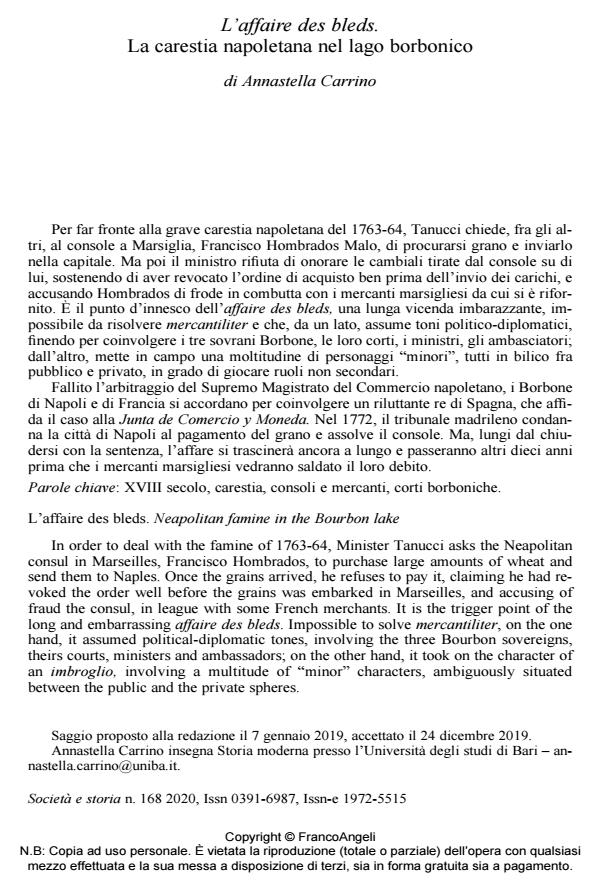L’affaire des bleds. Neapolitan famine in the Bourbon lake
Journal title SOCIETÀ E STORIA
Author/s Annastella Carrino
Publishing Year 2020 Issue 2020/168
Language Italian Pages 24 P. 233-256 File size 94 KB
DOI 10.3280/SS2020-168002
DOI is like a bar code for intellectual property: to have more infomation
click here
Below, you can see the article first page
If you want to buy this article in PDF format, you can do it, following the instructions to buy download credits

FrancoAngeli is member of Publishers International Linking Association, Inc (PILA), a not-for-profit association which run the CrossRef service enabling links to and from online scholarly content.
In order to deal with the famine of 1763-64, Minister Tanucci asks the Neapolitan consul in Marseilles, Francisco Hombrados, to purchase large amounts of wheat and send them to Naples. Once the grains arrived, he refuses to pay it, claiming he had revoked the order well before the grains was embarked in Marseilles, and accusing of fraud the consul, in league with some French merchants. It is the trigger point of the long and embarrassing affaire des bleds. Impossible to solve mercantiliter, on the one hand, it assumed political-diplomatic tones, involving the three Bourbon sovereigns, theirs courts, ministers and ambassadors; on the other hand, it took on the character of an imbroglio, involving a multitude of "minor" characters, ambiguously situated between the public and the private spheres. To find a solution acceptable to all parts, the Neapolitan and French kings agreed to ask the third Bourbon monarch to deal with the question through an independent court. In 1772, the Junta de Comercio y Moneta condemned the city of Naples to pay for the wheat and acquitted Hombrados. But this is was the end of the affaire. It would take ten more years for the Marseilles merchants to obtain the money due by the Neapolitans.
Keywords: 18th century, famine, consuls and merchants, the Bourbon courts.
- Practices, merchants and mercantilisms. Jews and the cereal trade in Trieste between Eastern Europe, the Po and the Mediterranean (18th century) Daniele Andreozzi, in Business History /2024 pp.672
DOI: 10.1080/00076791.2021.1932816 - Recent Articles on French History Jean-Pierre Hérubel, in French Historical Studies /2021 pp.561
DOI: 10.1215/00161071-9005035 - Quale storia della società? Uno sguardo sull'epoca moderna Paola Bianchi, in SOCIETÀ E STORIA 178/2023 pp.711
DOI: 10.3280/SS2022-178005
Annastella Carrino, L’affaire des bleds. La carestia napoletana nel lago borbonico in "SOCIETÀ E STORIA " 168/2020, pp 233-256, DOI: 10.3280/SS2020-168002